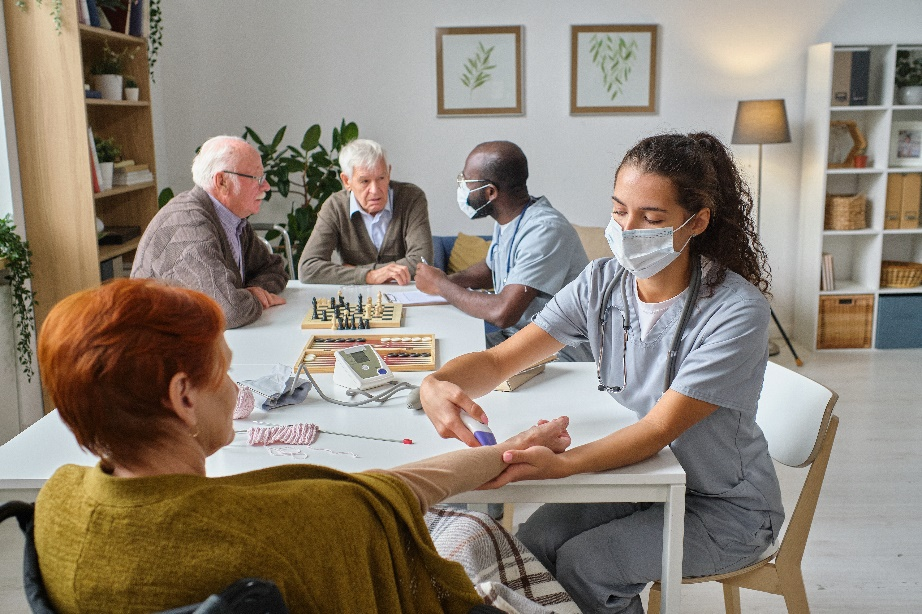As we age, our physical capabilities and needs evolve. Our homes, once havens of comfort and familiarity, may no longer fully accommodate our changing requirements. This necessitates adapting our living spaces to promote safety, accessibility, and continued independence – a concept we’ll refer to as senior-friendly living.
In this article, we’ll discuss considerations for designing senior-friendly living spaces and transforming your home into a safe and supportive environment that fosters well-being throughout your golden years.
Here’s what you need to know:
Prioritizing Safety and Fall Prevention
Falls are a leading cause of injuries and hospitalizations among seniors. Creating a senior-friendly living space requires prioritizing measures to minimize fall risks. Here are some crucial aspects to address:
- Flooring:Opt for slip-resistant flooring materials like low-pile carpet, vinyl tiles, or laminate wood flooring with textured surfaces. Avoid throw rugs that can cause tripping hazards.
- Lighting:Ensure adequate lighting throughout the living space. Install dimmer switches to adjust brightness based on time of day and individual needs. Consider nightlights in hallways and bathrooms for increased visibility during the night.
- Grab Bars:Install sturdy grab bars in bathrooms near bathtubs, showers, and toilets. Consider adding grab bars next to the bed and along staircases for additional support.
- Furniture Selection:Choose furniture with rounded edges and avoid sharp corners that could cause injury in case of a fall. Opt for chairs with firm cushions and good back support to help them rise and sit.
Enhancing Accessibility and Mobility
A senior-friendly living space should accommodate potential limitations in mobility. Here’s how to optimize accessibility:
- Clear Pathways:Ensure ample space in hallways and doorways to allow for easy maneuvering with walkers, wheelchairs, or other mobility aids. Remove clutter and furniture that may obstruct movement.
- Wider Doorways:Consider widening doorways to facilitate easier access for individuals using mobility aids.
- Ramps:If your home has multiple levels, installing ramps can eliminate the need for stairs, preventing potential falls.
- Lever Handles:Replace doorknobs with lever handles that are easier to operate, especially for individuals with limited hand strength or dexterity.
- Lowered Counters and Cabinets:In kitchens and bathrooms, consider lowering countertops and installing cabinets with pull-out shelves to make them easily accessible from a seated position.
Promoting Comfort and Independence
A senior-friendly living space should not only be safe but also foster a sense of independence and well-being. Here are some design elements that contribute to this:
- Lighting Controls:Install light switches and thermostats at accessible heights, eliminating the need for reaching or straining.
- Smart Home Technology:Consider incorporating smart home features like voice-activated lighting controls, electronically adjustable thermostats, and smart doorbells for convenience and security.
- Universal Design Features:Incorporate features like automatic door openers, self-closing drawers, and accessible shower controls to simplify daily tasks.
- Clear Communication Tools:Ensure readily available communication options like landline phones or video call devices to connect with loved ones or seek assistance in emergencies.

Addressing Specific Needs
While the tips mentioned above provide a general framework, it’s crucial to tailor your senior-friendly living space to address any specific needs.
- Vision Impairment:Increase contrast between walls and furniture, utilize brighter lighting, and install large-print labels on appliances and medication containers.
- Hearing Impairment:Consider amplified telephones and doorbells, and explore visual alert systems like flashing lights for smoke detectors and doorbells.
- Cognitive Decline:Minimize clutter and maintain a consistent layout to avoid confusion. Label cabinets and drawers clearly and incorporate visual cues like clocks and calendars.
Seeking Professional Guidance
Consulting with occupational therapists or certified aging-in-place specialists (CAPS) can be immensely beneficial. These professionals can assess your specific needs and provide tailored recommendations for modifying your living space to promote safety, accessibility, and continued independence.
Additional Considerations
- Emergency Alert Systems:Installing a medical alert system provides peace of mind, allowing seniors to call for help in emergencies.
- Home Safety Checklist:Conduct regular home safety checks to identify and address any potential hazards, such as loose wires, uneven flooring, or faulty smoke detectors.
- Bathroom Safety:Install grab bars in the shower and bathtub area, along with a shower seat for added stability. Consider a raised toilet seat for easier standing and sitting.
- Kitchen Safety:Relocate frequently used items to lower shelves and cabinets. Ensure proper lighting over stovetops and countertops.
- Visual Cues:Use contrasting colors for walls and flooring to improve depth perception. Install bright lighting fixtures throughout the living space.
- Social Connection:Designate a space for socializing and leisure activities. Encourage visits from family and friends to combat social isolation.
Technology for Seniors
- Fall Detection Systems:Explore wearable devices or monitoring systems that detect falls and send alerts to emergency services.
- Medication Management Systems:Consider electronic pill dispensers or reminder systems to ensure adherence to medication schedules.
Mental and Emotional Well-being
- Incorporate calming elements:Utilize nature-inspired décor, soothing color palettes, and comfortable furniture to create a relaxing environment.
- Maintain a sense of routine:Having a consistent daily schedule can provide structure and a sense of purpose, especially for individuals with cognitive decline.
- Engage in hobbies and interests:Encourage participation in activities that bring joy and fulfillment, fostering a sense of well-being and mental stimulation.
Image Filename: seniors-cycle
Image alt-text: a couple posing with bicycles
Image caption: Let Arrow Senior Living Advisors help you find the right senior assisted living community for your loved ones.
You must remember to:
- Personalize the space:Incorporate elements that reflect the individual’s personality and preferences, making the living space feel familiar and comfortable.
- Start small:Making modifications doesn’t have to be an overwhelming task. Begin with essential changes and gradually adapt the space as needs evolve.
- Regular evaluation:As your needs change, continuously assess your living space and adjust, ensuring continued safety and comfort.
Creating a senior-friendly living space is an ongoing process. By implementing the strategies outlined above and adapting your home to your evolving needs, you can ensure a safe, comfortable, and supportive environment that allows you to age in place with dignity and independence. Remember, prioritizing safety, accessibility, and promoting a sense of control are key elements in fostering a fulfilling and enriching life throughout your golden years.
Considering modifications to age safely at home? While some seniors thrive in their homes, others may require a more comprehensive support system. Arrow Senior Living Advisors can help you explore options and find suitable senior assisted living communities.
Whether you’re seeking memory care communities in Oklahoma or senior assisted living communities in Tulsa in the neighboring states of Oklahoma, Texas, Iowa, Kansas, Missouri, New Mexico, and Pennsylvania, we’re here to guide you.
Contact Arrow Senior Living Advisors today for a free consultation. We’ll work closely with you to understand your specific needs and help you find the best solution, promoting your loved one’s well-being, independence, and continued safety.



